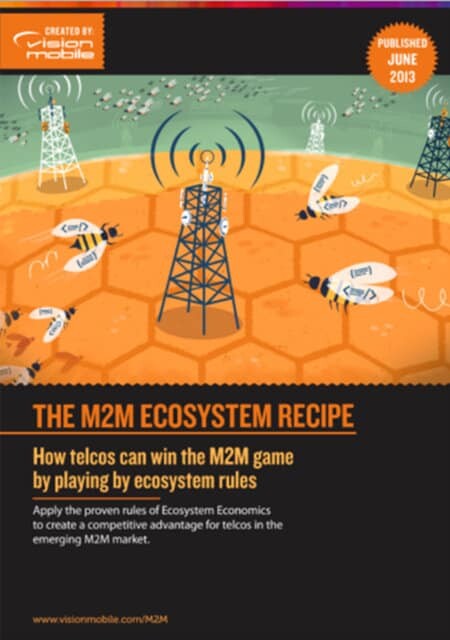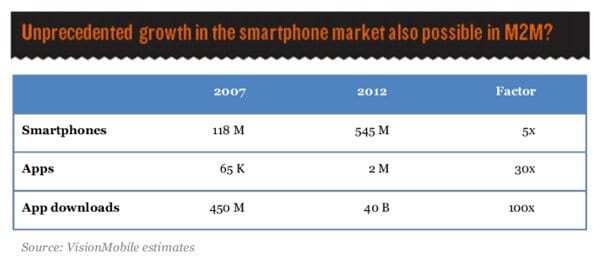Somehow, this notion that M2M is at the cusp of becoming the next iPhone/Smartphone doesn’t work for me.

Vision Mobile, an analyst outfit that I highly recommend following, just released a free research report about an M2M Ecosystem Recipe. It is a good report that tries to explain why M2M is set to boom and what service providers can do to stay relevant when that happens and not miss the boat as they did when the iPhone launched (hint: they lost the app economy and a lot of the “ownership” of the customer).
While the advice given is sound, and the storytelling of the Smartphone market and the app economy is compelling, I can’t really say I agree with the comparison to M2M.
The main premise of the report? Same way an application ecosystem rose from the ashes of the Symbian “ecosystem” in the embodiment of the iPhone (and Android) – the M2M market will undergo the same growth – question is, who will be the winner of this new ecosystem.

The paper goes on to analyze how an M2M ecosystem would look like, but I want to question the initial assumption here. The growth? 5x smartphones, 30x apps, 100x downloads – can that even happen in M2M?
The way I see it, M2M requires 3 main things:
- Connectivity
- Devices
- Service
The connectivity side can be achieved by attaching a service to a specific service provider or by going OTT – most probably over WiFi.
The devices part? That is highly dependent on the use case – M2M devices might be multipurpose but they are not as multipurpose as a smartphone. They can be cameras, a plethora of sensors, cars, etc. – the 5x growth for smartphones does nothing to talk about the growth of a specific M2M device in a specific vertical.
The services part? Usually they will be provided by the one designing and developing the devices, or to some extent created via localized partnerships – nothing as grand as the mobile app stores we see today.
No M2M device will reach in a year the revenue made in a month by Apple. While a specific M2M device might sell more devices than any smartphone, I assume its cost will be lower to the point of making little margin on the device itself. And these devices? They will offer little benefit to the end user – the service will be what matters here – nothing similar to how a smartphone have immediate benefit without any additional apps installed on it.
I also can’t see how a large ecosystem with more than tens of apps can be created for an M2M device (or service for that matter). To me, an M2M device isn’t the swiss army knife that our smartphones are.
The closest devices that can offer such utility are probably the Arduino and the Raspberry Pi, but both require more hardware and not only software to become real M2M devices.
What can change this? I can’t really say. Only thing that might is taking a smartphone chip, packing it up with a boatload of sensors of different types, lowering its cost ridiculously and then spreading it to the world. And even with that, I can’t see it booming as smartphones do.
M2M is probably a very lucrative business, but it is no iPhone.
–
That said, don’t let me discourage you – if M2M is your thing, then Vision Mobile’s report is a must read for you.
